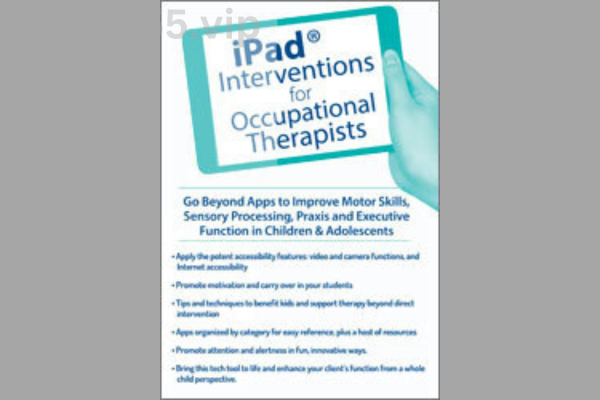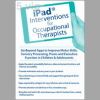iPad® Interventions for Occupational Therapists By Lorelei Woerner-Eisner – PESI
$219.00 Original price was: $219.00.$23.10Current price is: $23.10.
iPad® Interventions for Occupational Therapists: A Comprehensive Review – Digital Download!

iPad® Interventions for Occupational Therapists By Lorelei Woerner-Eisner – PESI
Overview

Harnessing iPad® Technology for Occupational Therapy Success
As the field of occupational therapy continues to evolve, technology has emerged as a key component in enhancing therapeutic interventions. The iPad® Interventions for Occupational Therapists workshop, led by expert Lorelei Woerner-Eisner, offers a comprehensive guide for practitioners looking to integrate this powerful tool into their practice. This workshop explores how iPads® can boost client engagement, strengthen therapist-client collaboration, and go beyond basic app usage to create personalized, effective therapy sessions. By applying the techniques outlined by Woerner-Eisner, occupational therapists can refine their approach and maximize therapeutic outcomes for children and adolescents.
Seamlessly Integrating iPads® into Therapy
Lorelei Woerner-Eisner emphasizes that while iPads® can be highly beneficial in therapy, their use must be intentional and tailored to each client’s unique needs. Rather than relying on a universal approach, therapists should integrate iPads® strategically, aligning their use with specific therapy goals related to motor development, cognitive skills, and sensory processing.
More than just a tool, the iPad® serves as a catalyst for engagement, helping children develop essential skills through interactive applications. Research has shown that structured use of technology in therapy settings can lead to measurable improvements in multiple developmental areas. Woerner-Eisner encourages therapists to view the iPad® as an integral part of their professional toolkit, rather than an occasional or secondary resource.
Selecting and Utilizing Apps Effectively
A major component of the workshop focuses on identifying the most effective applications for therapy sessions. Lorelei Woerner-Eisner categorizes different apps based on their therapeutic value, allowing occupational therapists to select tools that directly align with client goals. This structured approach ensures that technology is used with purpose, making each session meaningful and engaging.
For instance, some apps are designed to refine fine motor skills through activities that require precise hand movements, while others strengthen cognitive abilities by incorporating problem-solving exercises. Woerner-Eisner also highlights the built-in accessibility features of iPads®, such as video recording, camera functions, and internet connectivity, which can be leveraged to enhance therapy interactions and create an inclusive environment for clients of varying abilities.
Prioritizing Ergonomics and Proper Device Positioning
While selecting the right apps is essential, understanding the role of ergonomics in therapy is equally critical. The workshop stresses the importance of positioning the iPad® correctly to create a comfortable and supportive environment for clients. Woerner-Eisner highlights that proper ergonomics is particularly vital when working with children and adolescents, whose developing bodies require extra consideration.
Occupational therapists are introduced to adaptive equipment that can enhance the effectiveness of iPad® use, such as adjustable stands that position the device at an optimal viewing angle. These simple modifications help reduce strain, encourage better posture, and improve overall engagement during therapy. By customizing positioning based on each child’s unique physical needs, therapists can ensure that the iPad® remains a valuable and accessible therapeutic tool.
Tailoring Technology to Individual Client Needs
One of the standout features of this workshop is its emphasis on customized therapeutic approaches. Woerner-Eisner recognizes that every child presents distinct challenges and strengths, and she advocates for highly individualized therapy strategies.
By adapting interventions to fit each client’s learning style, therapists can optimize engagement and maximize progress. For example, visually oriented learners may benefit from vibrant, image-based applications, while children with auditory processing challenges may respond more effectively to sound-based exercises. This personalized approach ensures that therapy remains relevant, engaging, and productive, increasing the likelihood of long-term success.
Enhancing Client Engagement Through Technology
At its core, the workshop is about more than just applying technology—it’s about transforming therapy sessions into engaging, interactive experiences. Given that today’s children are naturally drawn to digital platforms, integrating iPads® into therapy can make sessions feel more enjoyable and motivating rather than a chore.
Studies published in the American Journal of Occupational Therapy support this concept, demonstrating that clients exposed to digital tools during therapy exhibit greater enthusiasm and participation, leading to improved therapeutic outcomes. Woerner-Eisner reinforces that when iPads® are used with clear intention and thoughtful strategies, they can significantly elevate the effectiveness of occupational therapy.
Ensuring Skill Retention Beyond Therapy Sessions
One of the key challenges in therapy is ensuring that progress made in sessions carries over into daily life. Woerner-Eisner equips therapists with practical techniques to reinforce learning outside of therapy, emphasizing the importance of home-based programs that integrate iPads®.
By educating parents and caregivers on how to use specific apps at home, therapists can create continuous learning opportunities that support skill retention. This collaborative approach strengthens the therapist-client-caregiver relationship, ensuring that the therapeutic benefits extend beyond the clinical setting and into everyday activities.
Conclusion: Empowering Therapists with Digital Tools
The iPad® Interventions for Occupational Therapists workshop by Lorelei Woerner-Eisner offers a transformative approach to integrating technology into therapy. Through strategic app selection, ergonomic considerations, and individualized interventions, therapists can enhance engagement and maximize therapeutic impact.
By adopting Woerner-Eisner’s insights, occupational therapists are better equipped to navigate the modern challenges of therapy, ensuring that iPads® become valuable, personalized tools that empower clients and improve outcomes. With the right strategies in place, technology can become a powerful ally in fostering development, learning, and long-term success in occupational therapy.
Frequently Asked Questions:
Business Model Innovation: We operate a group buying strategy, allowing participants to share costs and access popular courses at reduced prices. This model benefits individuals with limited financial resources, despite concerns from content creators about distribution methods.
Legal Considerations: The legality of our operations involves complex issues. Although we don’t have explicit permission from course creators to resell their content, there are no specific resale restrictions stated at the time of purchase. This ambiguity creates an opportunity for us to provide affordable educational resources.
Quality Control: We ensure that all course materials purchased are identical to those offered directly by the creators. However, it’s important to understand that we are not official providers. As such, our offerings do not include:
– Live coaching calls or sessions with the course author.
– Access to exclusive author-controlled groups or portals.
– Membership in private forums.
– Direct email support from the author or their team.
We aim to reduce the cost barrier in education by offering these courses independently, without the premium services available through official channels. We appreciate your understanding of our unique approach.
Be the first to review “iPad® Interventions for Occupational Therapists By Lorelei Woerner-Eisner – PESI” Cancel reply
You must be logged in to post a review.

 Barb Stepp’s NLP Master Practitioner By Barbara Stepp
Barb Stepp’s NLP Master Practitioner By Barbara Stepp 














Reviews
There are no reviews yet.